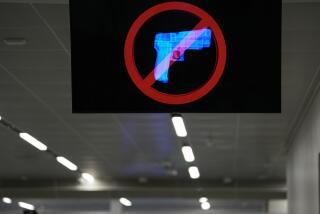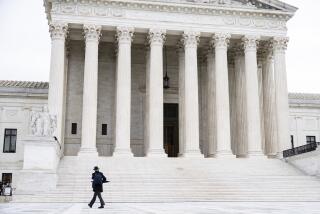Supreme Court Reaffirms Need for Miranda Warning : Law: Justices rule for third time in three years that a failure to inform suspects of their rights before questioning puts a conviction in jeopardy.
- Share via
WASHINGTON — Insisting again on strict enforcement of the Miranda rules, the Supreme Court on Wednesday told federal judges that they can second-guess the convictions of suspects who were not warned of their rights before confessing.
The 7-2 decision marked the third time in three years that the justices have stressed that they will not ignore instances in which police blatantly ignore the Miranda guidelines for questioning suspects.
The case involved an Alaska man who confessed after two hours of police questioning that he had killed his wife. But the man was not warned before his confession of his right to remain silent or to have a lawyer with him during questioning. A state judge, nonetheless, upheld the conviction by ruling that the man was not truly “in custody” during the interrogation.
Supreme Court Justice Ruth Bader Ginsburg, writing for the majority, said that the custody determination can be re-examined. She sent the case back to a federal appeals court in San Francisco for “an independent review” of the record.
The ruling comes as something of a surprise.
Over the last decade, the court has tilted in favor of police and prosecutors. In particular, the justices have sought to block federal judges from second-guessing convictions in death penalty cases.
The Miranda rule stands as a clear exception, perhaps because of a growing number of cases showing that police continue to evade the Miranda guidelines in their effort to obtain confessions. State judges have been reluctant to reverse convictions when suspects have admitted to brutal crimes.
Last year, for example, the justices ordered new hearings for a onetime Los Angeles-area ice cream truck driver who was convicted of murdering a Baldwin Park girl. The man, Robert E. Stansbury, had been picked up by police at his home at 11 p.m. and questioned before he was warned of his rights. Nonetheless, the California courts had upheld the use of his comments during his trial.
Three years ago, the justices rejected a bid by state prosecutors to have all Miranda cases put off limits to review by federal judges.
Until 1966, confessions were introduced as evidence so long as they were obtained voluntarily. But often, the defendant and the police told quite different stories about the circumstances of the questioning and it was hard for judges to decide whether the suspect had indeed confessed voluntarily.
The Miranda vs. Arizona case set a new and supposedly simpler rule. A suspect must be warned of his rights, the court said, whenever he is “taken into custody or otherwise deprived of his freedom of action in any significant way.”
Now, litigation often focuses on whether the suspect was “in custody” when he confessed.
The Alaska case began on Sept. 10, 1986, when two moose hunters discovered the body of Dixie Thompson, stabbed 29 times.
Five days later, state troopers asked her ex-husband, Carl Thompson, to come by their headquarters to identify her personal items. In reality, they wanted to question him.
Over the next two hours, they asked him about the crime, but also interjected several times: “You’re free to get up and walk out of here.” He stayed and finally confessed.
Last year, when his appeal reached them, the judges of the U.S. 9th Circuit Court of Appeals said that they had no power to reconsider the question of whether a defendant was in custody during questioning.
Disagreeing in Thompson vs. Keohane, 94-6615, Ginsburg said that a federal judge can make the “ultimate determination . . . whether a reasonable person would feel he was free to leave and break off police questioning.”
More to Read
Get the L.A. Times Politics newsletter
Deeply reported insights into legislation, politics and policy from Sacramento, Washington and beyond. In your inbox three times per week.
You may occasionally receive promotional content from the Los Angeles Times.











